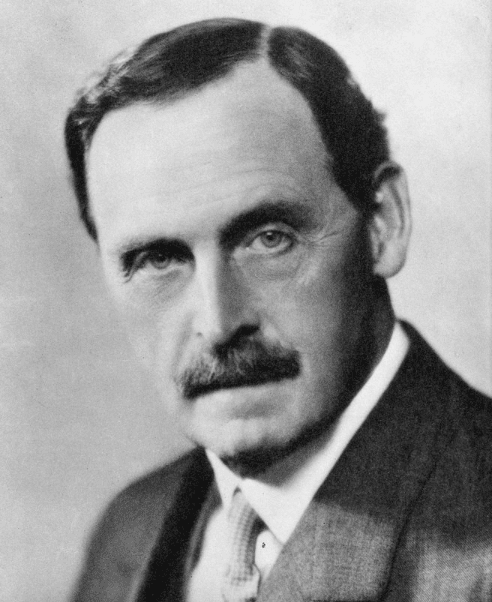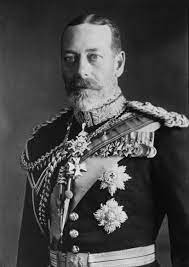Seamus O’Mahony
London, England

Bertrand Dawson, Lord Dawson of Penn (1864-1945), was the most eminent British doctor in the years between the two world wars. He was both a skilled medical politician (twice president of the British Medical Association, eight-times president of the Royal College of Physicians) and a brilliantly successful private practitioner. His bedside manner was impeccable; he had the enviable ability to inspire confidence in his patients and was said to possess a “Himalayan calm.” Dawson was not universally adored, however. Canon F.A. Iremonger, the Dean of Lichfield, wrote that Dawson “seemed to me almost too handsome, too soigné, too much a man of the world.”1
Dawson’s most prominent patient was George V. The King fell seriously ill in November 1928 with streptococcal pneumonia and septicemia. In this pre-antibiotic era, the patient was treated at home—“home” being Buckingham Palace. Dawson called in several eminent doctors, including the Regius Professors of Physic at Oxford and Cambridge. “When a King is the patient,” wrote the surgeon and writer R. Scott Stevenson, “the inclination is always to spread the responsibility.”2 In all, thirteen doctors were involved in the case; daily bulletins were issued, all signed by Dawson. After three weeks, the King showed no sign of improvement, and one of his nurses, Sister Catherine Black, concluded that he was dying. “The doctors,” she later wrote, “had done everything that could be done. Human skill ended there.”1 But Dawson was convinced that there must be an empyema, and on December 12 he carried out a needle aspiration of the right lung, draining 16oz of pus. That evening, the thoracic surgeon Sir Hugh Rigby performed a formal drainage of the abscess, with resection of two ribs.
Although George V was an irritable man and a bad patient, he slowly recovered. On the 9th of February 1929, he was moved to Craigwell House in Bognor on the Sussex coast. Dawson thought the sea air would aid the King’s recovery. The town later successfully petitioned George V to have the suffix “Regis” attached in honor of its role in his recovery, and thereafter was known as Bognor Regis. On February 12, Dawson permitted the King—a heavy smoker—his first cigarette. Over three months in Bognor he gradually recovered, and in May was moved to Windsor Castle. Later that month, however, George V relapsed, with a localized abscess at the site of his thoracotomy. The abscess burst on May 31; it was rumored that this discharge was caused by the King’s over-vigorous laughter in response to a ribald joke told by the Labour politician, Jimmy Thomas. (Thomas, who rose from railwayman to cabinet minister, was an unlikely intimate of this dour Hanoverian.)
On June 3, fifteen of the many doctors and nurses involved in George V’s care were bestowed with honors, ranging from the lowly MBE (Member of the Most Excellent Order of the British Empire) for the four nurses, to knighthoods and baronetcies for the doctors. Dawson (a peer since 1920), was made a Privy Councillor, an unprecedented honor for a doctor. This was all somewhat premature, as was the ceremony of thanksgiving for the King’s recovery at Westminster Abbey on July 7. The irony was not lost on the patient, who told Dawson, “Fancy a thanksgiving service with an open wound in your back!”3 Over the following days, Dawson consulted with five colleagues. Sir Hugh Rigby advised him that further surgery would be necessary, and that Wilfred Trotter, of University College Hospital (UCH) London, might “assist” him. Trotter was then, by common consent, the most skilled surgeon in Britain, having made major contributions to both neurosurgery and head and neck surgery.4 The story is told that when the palace told Trotter that they would send a car to collect him, he replied, “That won’t be necessary: I can take the 14 bus.”5
On July 15, Trotter and Rigby drained the abscess cavity. Within a week, the purulent discharge had ceased, and George V went on to make a full recovery. R. Scott Stevenson, who knew most of the doctors involved (especially Trotter), wrote in 1962:
Sir Hugh Rigby was a pleasant personality, a careful, rather diffident surgeon and he obviously was not drastic enough when he operated on George V’s empyema. After drifting on for six months with a discharging sinus, the empyema was cured in a week when Mr Wilfred Trotter treated the King as he would have done any other patient in hospital.2

Trotter was offered a baronetcy, but—rather stylishly—declined the honor. Diffident, witty, and thoughtful, he was too much his own man. His 1915 best-selling book Instincts of the Herd in Peace and War6 was a major work of social psychology, but thereafter, Trotter devoted himself to his craft and to teaching. The psychoanalyst Ernest Jones, his best friend and brother-in-law, wrote, “With Trotter rank, authority, veneration counted for nothing.”7
After George V’s recovery, Trotter disappeared into obscurity, while Dawson was hailed as “the doctor who pulled the King through.” The King, however, enjoyed only five years of often indifferent health, falling mortally ill in December 1935 at his Sandringham Estate in Norfolk with a combination of heart failure and chronic obstructive pulmonary disease (“bronchial catarrh”). Dawson once again presided over the monarch’s treatment, but on this occasion, there was no prospect of recovery. As before, Dawson wrote regular bulletins for the press, and at 9:25 p.m. on the evening of January 20, 1936, he wrote on a menu-card his now-famous bulletin: “the King’s life is moving peacefully to its close.” George V died at 11:55 p.m. His biographer John Gore wrote: “the Queen and his children kept vigil round his bed and, as he drew his last breaths, the archbishop offered up the commendatory prayers.”3
After the death of George V, Dawson’s peerage was upgraded to a hereditary viscountcy; he died in 1945, aged eighty, full of years and honors. His funeral service was held at Westminster Abbey, conducted by his friend the Archbishop of Canterbury Cosmo Lang. But rumors about Dawson’s treatment of the late King had been in circulation for years, with the often-recited clerihew:
Lord Dawson of Penn
Has killed many men
That is why we sing
“God Save the King”
It was said that this ditty had been composed by Dawson’s friend and rival, the famous surgeon Lord Moynihan of Leeds,8 but no one is quite sure. The rumors were finally given some substance in 1986, when Dawson’s biographer Francis Watson wrote an essay for History Today entitled “The Death of George V.”9 Watson’s respectful, rather dull biography of Dawson had appeared many years before in 1950. Watson was now seventy-nine and died less than two years later. He was reluctant, he said, to describe in his 1950 biography the true circumstances of George V’s death, because Dawson’s widow and many others involved were still alive. Watson had access to Dawson’s private diary, which contained this account of the King’s final hours:
Hours of waiting just for the mechanical end when all that is really life has departed only exhausts the onlookers . . . I therefore decided to determine the end and injected (myself) morphia gr. ¾ & shortly afterwards cocaine gr.1 into the distended jugular vein: ‘myself’ because it was obvious that Sister B. [Catherine Black] was disturbed by this procedure. In about ¼ an hour—breathing quieter—appearance more placid – physical struggle gone.
Dawson also mentioned “the importance of the death receiving its first announcement in the morning papers rather than the less appropriate evening journals.” Dawson, having given the lethal injection, telephoned his wife, instructing her to ask The Times to hold publication as the King’s death was imminent.
This essay was a minor sensation; some questioned these astonishing claims. I am inclined to believe Watson: he had access to Dawson’s diary, and clearly wanted, near the end of his life and career, to set the record straight, when all the participants were long dead. Dawson—who had died forty-one years before—was now accused of hypocrisy (not to mention murder and arrogance10), as he had opposed Lord Moynihan in the House of Lords in a debate on euthanasia in 1936. He was not opposed to euthanasia per se; he was opposed to legalization of it, as “this is something which belongs to the wisdom and conscience of the medical profession and not to the realm of law.”
“We tend to get at the summit of our professions,” wrote Wilfred Trotter in Instincts of the Herd, “only those rare geniuses who combine real specialist capacity with the arts of the bagman.”6 Dawson, feted and famous, was such a genius. Yet it is the self-effacing Trotter, who happily took the bus over the chauffeured car, who treated George V “as he would have done any other patient,” who claims admiration.
References
- Watson W. Dawson of Penn. London: Chatto and Windus; 1941.
- Scott Stevenson R. Teamwork and the recovery of King George V. In: Famous Illnesses in History. London: Eyre & Spottiswoode; 1962:13-22.
- Gore J. King George V: A Personal Memoir. London: John Murray; 1941.
- Pilcher RS. Wilfred Trotter F.R.S., F.R.C.S. Ann Roy Coll Surg Engl 1973;53:71-83.
- Black SP. Wilfred Trotter. Surg Neurol 1983;19:199-204.
- Trotter W. Instincts of the Herd in Peace and War. London: Unwin; 1916. New edition Oxford University Press; 1953.
- Jones E. Free Associations: Memories of a Psychoanalyst. New York, Basic Books: 1959.
- Rose K. King George V. London: Weidenfeld & Nicolson; 1983.
- Watson F. The Death of George V. History Today 1986;36(12)21-30.
- Rolland Ramsay JH. A king, a doctor, and a convenient death. Brit Med J 1994;308:1445.
SEAMUS O’MAHONY is a physician and author. He worked for many years as a gastroenterologist and is currently visiting professor at the Centre for the Humanities and Health, King’s College London. He has published extensively in the medical humanities. He is the author of three book, including The Way We Die Now (2016), Can Medicine Be Cured? (2019), and The Ministry of Bodies (2021). He is a member of the Lancet Commission on “The Value of Death.”
Highlighted in Frontispiece Volume 13, Special Issue – Fall 2021

Leave a Reply